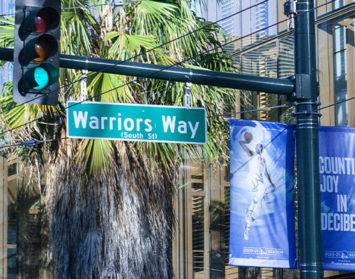Can it be that the San Diego Chargers have found a new stadium site literally in their own back yard?
I’m beginning to think so as both the club and city, along with assorted civic boosters, are continuing to snuggle up to a 10-acre site in downtown San Diego’s East Village, just a couple of blocks from Petco Park.
Welcome back, Bolts. It’s about time.
The Chargers have been on a quest for a new stadium location longer than most of us care to remember. After being told by then City Attorney Mike Aguirre that the present Mission Valley location wouldn’t accommodate their plans for a new stadium, the Chargers hit the road to look elsewhere. There were a couple of site possibilities in Chula Vista, one in National City, one or two in Oceanside, the promise of a new stadium in east Los Angeles County, and another proposal to re-develop the Mission Valley site.
Then, a 60-acre site in Escondido at the intersection of two major freeways surfaced. Smack in the middle of a redevelopment area, that location seemed to have everything a new stadium would need: abundant acreage, a location adjacent to fixed-rail and bus transportation services, a plan to accommodate the need for 19,000 parking spaces, and a supportive political climate—all factors that could tempt the Spanos family to move the team to the North County hinterlands.
What it doesn’t have, though, is a San Diego address. The notion of the Escondido Chargers apparently was real enough to rally the downtown San Diego politicos to discover they had a site to offer the team after all, near 17th Street and Imperial Avenue.
The devil’s in the details, though. Is the site big enough to accommodate a stadium big and fancy enough to be Super Bowl-compliant? Are there physical or environmental problems with the site? Where will the $800 million come from to build the 62,000-seat publicly owned stadium? That last question might be better phrased, “Who will pay the $800 million,” since the concept of a “publicly owned” stadium triggers the next question: How much public financing will it take after the Chargers kick in a share of the cost?
Good questions, to be sure, but all questions that need to be answered in the positive, because of three imperatives in proper sequence: (1) The San Diego Chargers must stay in San Diego, (2) In order to do so, they need a new stadium, and (3) That new stadium should be in the heart of the city’s downtown.
The Chargers’ lead negotiator, Mark Fabiani, calls the site the team’s “last best option.” Not sure what he means by “last,” but, it’s the city’s best option for a major downtown project as well—far superior to the idiotic proposal for a new Civic Center building that’s being bandied about by city hall wags and others. Stay tuned in a future column for more on that scheme.
Meanwhile, back to the issue at hand. To put it in baseball parlance, the proposed stadium site is a home run. It’s close to Petco Park and can share parking and other infrastructure with that facility. It’s also convenient to the San Diego Convention Center and can play a major role in that center’s expansion plans. There’s also an unparalleled inventory of hotel rooms within walking distance, along with restaurants, night spots and other commercial amenities. Last, and most important, the site has a San Diego Zip Code. The Chargers won’t have to shed written, verbal, and graphic references to their hometown in order to morph into “The Chargers” or, God forbid, have to adopt a new city into the team’s name.
Back to the financing issue. All sorts of cost-sharing ideas are being explored, including the Chargers kicking $200 million into the kitty and whether the NFL’s exhausted “G3” stadium loan program might be replenished to provide $100 million. That leaves a $500 million gap as a “Hail Mary” pass to local taxpayers. You can well imagine the spectrum of public opinion over that issue ranges from “not one dime!” to “just make it happen.”
At this writing, the San Diego City Council is scheduled to vote June 22 on raising the spending cap of the Centre City Development Corporation to cover that amount through tax increment bonds. Beyond that, there are myriad details to handle before taking it to the voters who, of course, will have the final say.
As to keeping NFL football in San Diego, the ball’s on the five-yard line. Can we take it into the end zone?
Jason Hughes is founder of Hughes Marino, an award-winning commercial real estate company with offices across the nation. A pioneer in the field of tenant representation, Jason has exclusively represented tenants and buyers for more than 30 years. Contact Jason at 1-844-662-6635 or jason@hughesmarino.com to learn more.









